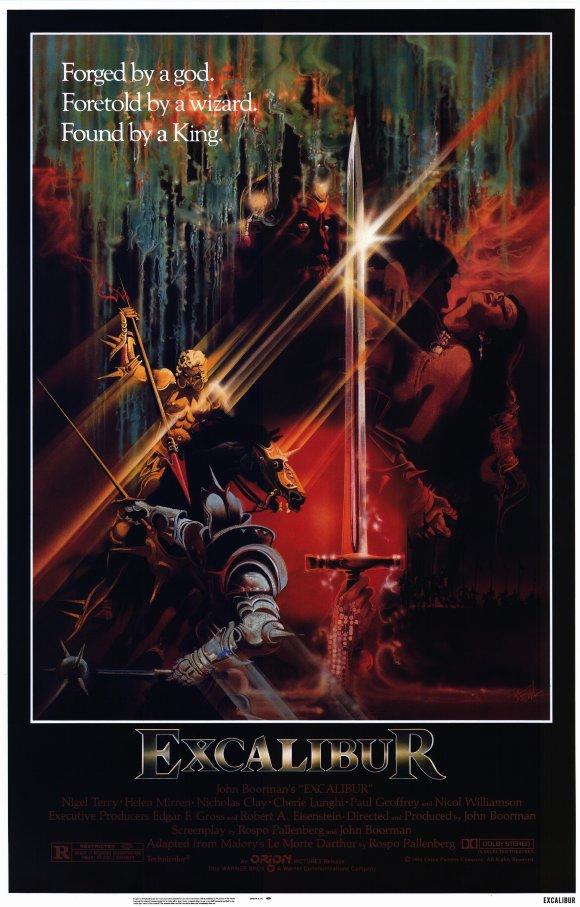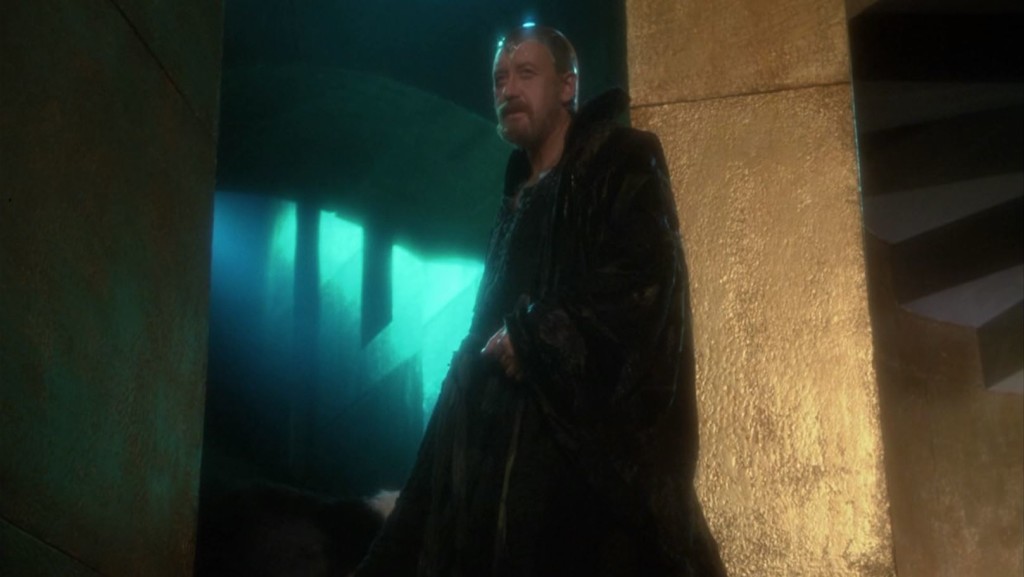
John Boorman is not after realism with Excalibur (1981). The dialogue, the characterizations, the behaviors – none of these are intended to replicate real life, but are deliberately outsized, almost predetermined. The characters behave as they are intended to behave: as the story demands. Lancelot and Guenevere fall in love at first sight because they must. The Queen gallops out of Camelot for her illicit tryst because she is compelled to do so, and one gets the idea it’s more than just burning desire that speeds her along. It is a film told from Merlin’s point of view. Merlin knows all that will occur, and King Arthur and his Round Table are just players on the stage. Boorman drives the action from a similar perspective. The Arthurian romance is well known, and many times retold. Boorman is after myth. He was well suited to the approach, even if his cinematic mythmaking had produced mixed results in the recent past: Zardoz (1974) is a science fiction film that could be called purely intellectual if it weren’t so reliant upon its dazzling cinematography, and it keeps the viewer at a distance, telling its abstract story in symbols; but it’s much, much harder to love Exorcist II: The Heretic (1977), in which a city-block-destroying tempest of psychic energy does nothing to bring us closer to the supposed emotional turmoil of its characters. (But Richard Burton does seem to be very upset about something, doesn’t he?) Excalibur began life as an adaptation of The Lord of the Rings, and in the wake of that project’s collapse, he was able to recycle much of the same preproduction work, including set designs. Although The Lord of the Rings would have been tricky to pull off in the pre-CG age, it might have been easier to emotionally relate to Frodo and Samwise instead of Arthur, Lancelot, Guenevere, and Merlin, who are so archetypal that at times they hardly seem to breathe. T.H. White cracked the problem with his novel The Once and Future King. The behaviors of these characters suddenly made sense: Arthur keeps himself in denial of his wife’s affair with his best friend for the sake of maintaining stability, until his own insistence on law and justice undoes the trio; Merlin’s prophetic talents are expanded to reveal a man living his life backward, resigned to the immobility of fate while sardonically engaged in what are actually the events of his own past; so much of the behavior of the children of Morgause the witch – later Knights of the Round Table – depend entirely upon their tragic family history and Arthur’s role in it; and so on. But Boorman’s approach would not be psychoanalytical, like White’s. He reached back to Thomas Mallory’s 15th century Le Morte d’Arthur, and embraced the larger-than-life quality of the Arthurian cast. Arthur, here, is more than just a boy seeking peace and righteousness. He is England itself, from its haunted forests to its stony shores. When he falls into depression, so does the very land.
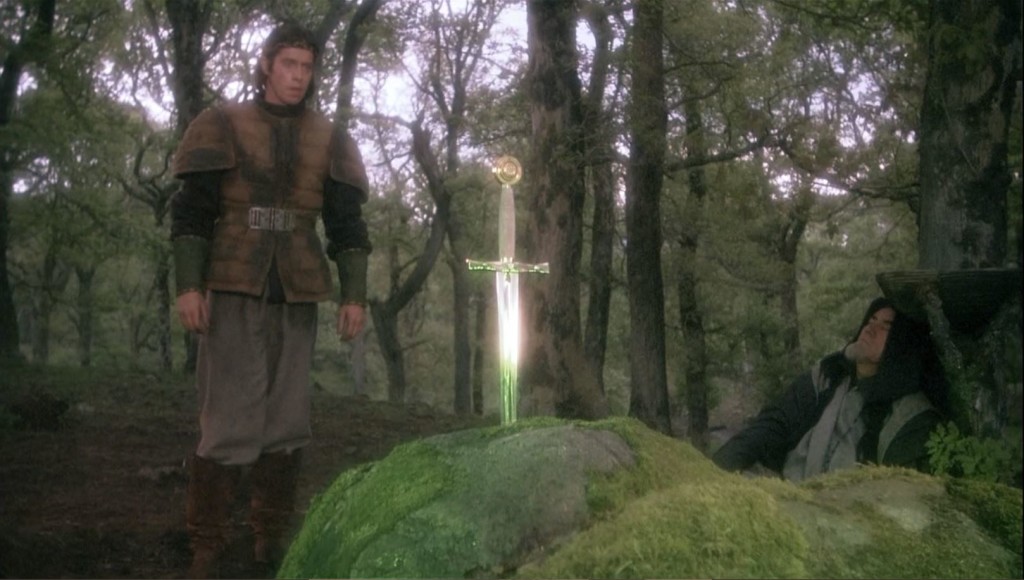
Young Arthur (Nigel Terry) discovers the Sword in the Stone.
As with Zardoz, a lot of the film’s success depends on how great it all looks. This nascent England is covered with seeping mist, moss-draped trees, and a shimmering green light that seems to reflect off anything remotely shiny. I tried keeping a tally of everything glittering green, in hopes of deciphering a meaning behind the motif; but eventually I gave up. There’s green light shining off damn near everything. The best I can suggest is that it represents the landscape’s very unreality. This is not historical England, but a land of primal legends. The green light reminds of that departure from logic and reality; it is the magic of nature, of Merlin, inherent in everything, which must ultimately fade away with the forward march of the modern, and the departure of Arthur to Avalon. Excalibur also fits neatly into the string of post-Star Wars fantasy films that burnish retro storylines (in George Lucas’s case, Flash Gordon serials; in Boorman’s, material much, much older) with state-of-the-art visual spectacle. Fantasy escapism now had cred. But even though Boorman knew how to deliver the spectacle, he was less interested in the escapism aspect. Even with its potent additions of R-rated sex and violence, Excalibur has a bit of an “eat your vegetables” quality. It takes its source material seriously, and is intent on condensing hundreds and hundreds of pages’ worth of Arthurian myth into a relatively lean 140 minutes. The first cut was about three hours long. That still doesn’t seem long enough; but regardless, the final version of the film feels rushed and confusing. It helps to have more than just a passing understanding of the original tales to follow along. The film is downright scholarly.
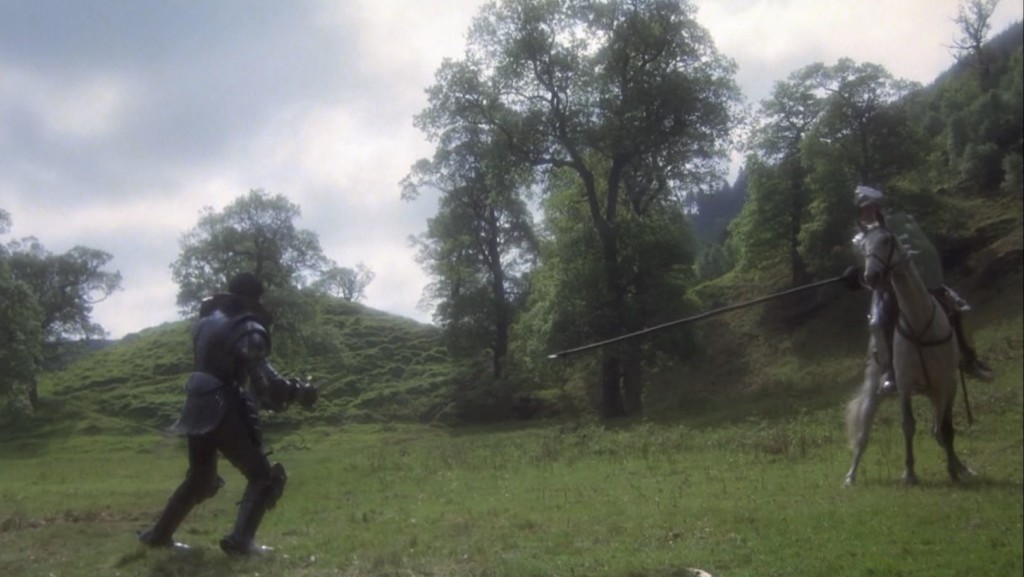
King Arthur duels with Lancelot of the Lake on their first meeting.
Boorman’s take begins with Arthur’s father, Uther Pendragon (Gabriel Byrne), wielding Excalibur and taking counsel from Merlin (Nicol Williamson). Uther is a man of brutal rage and selfish lust, the opposite of the man that Arthur will become. He wages war in scenes framed constantly by flame, as though all of England were burning. His truce with the Duke of Cornwall (Corin Redgrave, brother of Vanessa and Lynn) is threatened by his attraction to the Duke’s young wife, Igrayne (Katrine Boorman, the director’s daughter), and he persuades Merlin to use sorcery to satisfy his carnal desires. The result of the union is Arthur, but even after Cornwall dies and Uther claims his castle and territory, Merlin takes for payment the young boy to raise on his own. Uther, mortally wounded in battle, plunges Excalibur into a stone. Years later, a teenage Arthur (Nigel Terry) accidentally pulls the sword from the stone, fulfilling Merlin’s prophecy that only the true king can do so. Among his first allies is Sir Leondegrance (Patrick Stewart), and after helping him lay siege to a castle, he seals the alliance by marrying the man’s daughter, Guenevere (Cherie Lunghi). Soon he meets Sir Lancelot of the Lake (Nicholas Clay), and begins gathering his Knights of the Round Table, including Gawain (Liam Neeson), Uryens (Keith Buckley), and Perceval (Paul Geoffrey), who introduces himself to Lancelot as a starving thief but soon proves to be the most pure-hearted of all. Meanwhile, Merlin recognizes the growing threat of Igrayne’s daughter Morgana (Helen Mirren), who uses magic to seduce her half-brother Arthur, intending to give birth to a powerful son, Mordred, that she can place on the throne.
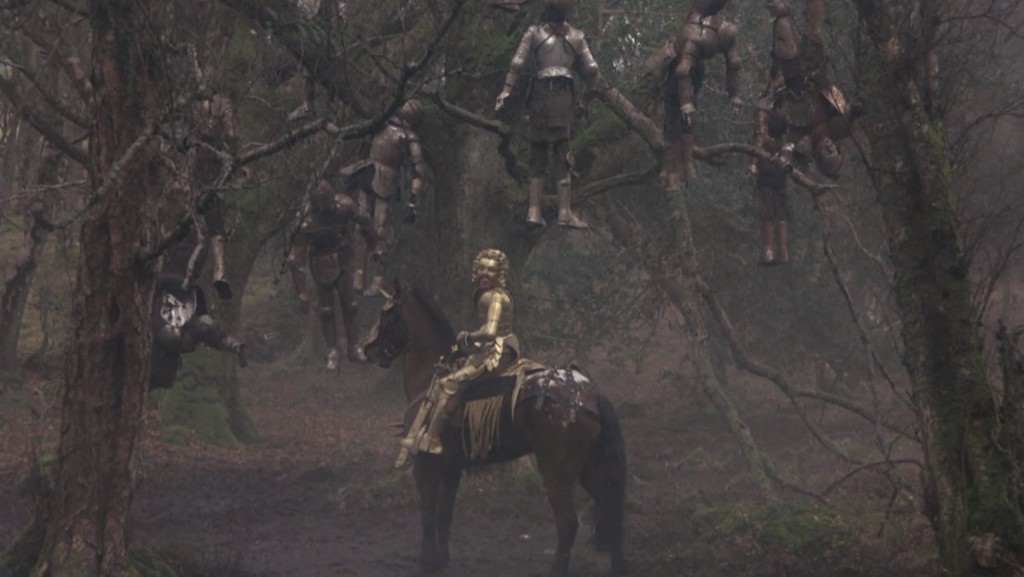
Young Mordred leads Perceval astray on his quest for the Holy Grail.
Excalibur, in its present form, condenses characters and plot (“Morgana” has elements of both Morgause and Morgan Le Fay, and Boorman focuses on but a small number of Knights of the Round Table). It also rushes forward from one episode to the next; at times it feels like King Arthur: The Cliff’s Notes. Novices to the story can be forgiven for being mystified as to why, late in the film, the knights are suddenly looking for the Holy Grail. But it’s the love triangle which feels most rushed; the Grailquest, by contrast, stands out for its cinematic qualities. Boorman goes full Zardoz, telling the story of Perceval’s lonely journey through hallucinatory imagery and surrealist flourishes: the ghastly corpse of a knight in a cabin on a mountainside; a laughing boy in a golden mask standing beneath a tree of strangled knights in armor like a grotesque mobile; a castle whose drawbridge lowers to glowing light and the image of the pouring Grail, and Arthur behind it, a shining figure of Christ. Best of all is Arthur’s Fisher King-like restoration at a sip from the Grail. To the strains of Wagner he and his company ride through new-blossoming trees, and fluttering white petals – the country restored along with its king. As with Zardoz, the film is dominated by classical music (“Siegfried’s Funeral March” forming the ominous main theme), as Boorman shrinks from anything too contemporary. Still, the battlements of Camelot shimmer metallic like something in a science fiction film, and Nicol Williamson’s eccentric, almost anachronistic portrayal of Merlin feels like a Pythonesque choice. Those are the anomalies. Everything else here is stilted by design. The dialogue is direct and lacking any subtlety; the characters are what they do. Excalibur bears the Arthurian myths like a colorful cloak, but it’s all surface. It’s gorgeous, admirable, and, at its best, stirring. But it never catches its breath, and in the film’s race to squeeze in as much story as it can, I find myself missing T.H. White’s patience, insight, and wisdom. Admittedly, Boorman’s characters are meant to be what they are: archetypes that are little more than suits of armor, but reflecting everywhere that inexplicable green light.
